Range Rover

Range Rover

| Range Rover | |
|---|---|
| Overview | |
| Manufacturer | Land Rover |
| Production | 1970–present |
| Assembly | Solihull plant,Solihull, United KingdomEnfield, Australia[1] |
| Body and chassis | |
| Class | SUV |
| Layout | Front-engine, four-wheel-drive |
| Range Rover "Classic" | |
| Overview | |
| Production | 1970–1994 |
| Assembly | Solihull plant,Solihull, United KingdomEnfield], Australia[1] |
| Body and chassis | |
| Body style | 3-doorSUV5-door SUV |
| Related | Land Rover Discovery |
| Powertrain | |
| Engine | 3.5 L V8 130 hp carburettor 3.5 L V8 155 hp 3.9 L V8 182 hp 4.2 L V8 200 hp 2.4 L 112 hp VM turbodiesel 2.5 L 119 hp VM turbodiesel 2.5 L 111 hp 200TDi turbodiesel 2.5 L 111 hp 300TDi turbodiesel |
| Dimensions | |
| Wheelbase | 100.0 in (2,540 mm) (SWB)108.0 in (2,743 mm) (LWB) |
| Length | 175 in (4,445 mm) (SWB)183 in (4,648 mm) (LWB) |
| Width | 70.1 in (1,781 mm) |
| Height | 70.9 in (1,801 mm) (1970–1980)70.1 in (1,781 mm) (1980 onwards) |
| Range Rover (P38A) | |
| Overview | |
| Production | 1994–2002 |
| Body and chassis | |
| Body style | 5-doorSUV |
| Powertrain | |
| Engine | 4.0 LRover V84.6 LRover2.5 LBMW M51Turbodiesel I6 |
| Transmission | 4-speedautomatic5-speedmanual |
| Dimensions | |
| Wheelbase | 108.1 in (2,746 mm) |
| Length | 185.5 in (4,712 mm) |
| Width | 74.4 in (1,890 mm) |
| Height | 71.6 in (1,819 mm) |
| Range Rover (L322) | |
| Overview | |
| Production | 2002–2012 |
| Body and chassis | |
| Body style | 5-doorSUV |
| Powertrain | |
| Engine | petrol engines:4.2 L 4.4 LBMW M624.4 LJaguar AJ-V85.0 Ldiesel engines:3.0 LBMW M57TD I6(2002–2006) 3.6 LFord Lion V8TD(2006–2010) 4.4 LFord TD |
| Transmission | 8-speed automatic[10](since 2010 only non-NAS markets)6-speed automatic (since 2005)5-speed automatic (2002–2005) |
| Dimensions | |
| Wheelbase | 113.4 in (2,880 mm) |
| Length | 194.9 in (4,950 mm) (2002–2005) 195.7 in (4,971 mm) (since 2006)195.9 in (4,976 mm) |
| Width | 75.7 in (1,923 mm) (2002–2009)76.1 in (1,933 mm) (since 2010) |
| Height | 73.3 in (1,862 mm) (2002–2005) 74.9 in (1,902 mm) (2006–2009)73.9 in (1,877 mm) (since 2010) |
| Range Rover (L405) | |
| Overview | |
| Production | 2012[11]–present |
| Assembly | Solihull Plant, England |
| Designer | Gerry McGovern |
| Body and chassis | |
| Body style | 5-doorSUV3-door SUV (SV Coupé)[12] |
| Powertrain | |
| Engine | 3.0 LV6diesel4.4 LV8diesel 3.0L V6 petrol 5.0 L V8 petrol[13] |
| Transmission | 8-Speed ZFAutomatic |
| Dimensions | |
| Wheelbase | 2,922 mm (115.0 in)[13] |
| Length | 4,999 mm (196.8 in)[13] |
| Width | 2,073 mm (81.6 in)[13] |
| Height | 1,835 mm (72.2 in)[13] |
The Land Rover Range Rover (generally known simply as a Range Rover) is a full-sized luxury sport utility vehicle (SUV) from Land Rover, a marque of Jaguar Land Rover. The Range Rover was launched in 1970 by British Leyland. This Flagship model is now in its fourth generation.
Jaguar Land Rover has also extended the use of the Land Rover Range Rover sub-brand with the introduction of Range Rover Evoque, the Range Rover Velar and the Range Rover Sport.
| Range Rover | |
|---|---|
| Overview | |
| Manufacturer | Land Rover |
| Production | 1970–present |
| Assembly | Solihull plant,Solihull, United KingdomEnfield, Australia[1] |
| Body and chassis | |
| Class | SUV |
| Layout | Front-engine, four-wheel-drive |
| Range Rover "Classic" | |
| Overview | |
| Production | 1970–1994 |
| Assembly | Solihull plant,Solihull, United KingdomEnfield], Australia[1] |
| Body and chassis | |
| Body style | 3-doorSUV5-door SUV |
| Related | Land Rover Discovery |
| Powertrain | |
| Engine | 3.5 L V8 130 hp carburettor 3.5 L V8 155 hp 3.9 L V8 182 hp 4.2 L V8 200 hp 2.4 L 112 hp VM turbodiesel 2.5 L 119 hp VM turbodiesel 2.5 L 111 hp 200TDi turbodiesel 2.5 L 111 hp 300TDi turbodiesel |
| Dimensions | |
| Wheelbase | 100.0 in (2,540 mm) (SWB)108.0 in (2,743 mm) (LWB) |
| Length | 175 in (4,445 mm) (SWB)183 in (4,648 mm) (LWB) |
| Width | 70.1 in (1,781 mm) |
| Height | 70.9 in (1,801 mm) (1970–1980)70.1 in (1,781 mm) (1980 onwards) |
| Range Rover (P38A) | |
| Overview | |
| Production | 1994–2002 |
| Body and chassis | |
| Body style | 5-doorSUV |
| Powertrain | |
| Engine | 4.0 LRover V84.6 LRover2.5 LBMW M51Turbodiesel I6 |
| Transmission | 4-speedautomatic5-speedmanual |
| Dimensions | |
| Wheelbase | 108.1 in (2,746 mm) |
| Length | 185.5 in (4,712 mm) |
| Width | 74.4 in (1,890 mm) |
| Height | 71.6 in (1,819 mm) |
| Range Rover (L322) | |
| Overview | |
| Production | 2002–2012 |
| Body and chassis | |
| Body style | 5-doorSUV |
| Powertrain | |
| Engine | petrol engines:4.2 L 4.4 LBMW M624.4 LJaguar AJ-V85.0 Ldiesel engines:3.0 LBMW M57TD I6(2002–2006) 3.6 LFord Lion V8TD(2006–2010) 4.4 LFord TD |
| Transmission | 8-speed automatic[10](since 2010 only non-NAS markets)6-speed automatic (since 2005)5-speed automatic (2002–2005) |
| Dimensions | |
| Wheelbase | 113.4 in (2,880 mm) |
| Length | 194.9 in (4,950 mm) (2002–2005) 195.7 in (4,971 mm) (since 2006)195.9 in (4,976 mm) |
| Width | 75.7 in (1,923 mm) (2002–2009)76.1 in (1,933 mm) (since 2010) |
| Height | 73.3 in (1,862 mm) (2002–2005) 74.9 in (1,902 mm) (2006–2009)73.9 in (1,877 mm) (since 2010) |
| Range Rover (L405) | |
| Overview | |
| Production | 2012[11]–present |
| Assembly | Solihull Plant, England |
| Designer | Gerry McGovern |
| Body and chassis | |
| Body style | 5-doorSUV3-door SUV (SV Coupé)[12] |
| Powertrain | |
| Engine | 3.0 LV6diesel4.4 LV8diesel 3.0L V6 petrol 5.0 L V8 petrol[13] |
| Transmission | 8-Speed ZFAutomatic |
| Dimensions | |
| Wheelbase | 2,922 mm (115.0 in)[13] |
| Length | 4,999 mm (196.8 in)[13] |
| Width | 2,073 mm (81.6 in)[13] |
| Height | 1,835 mm (72.2 in)[13] |
History
The Rover Company (originator of the Land Rover marque) was experimenting with a larger model than the Land Rover Series in 1951, when the Rover P4-based two-wheel-drive "Road Rover" project was developed by Gordon Bashford.[2] This was shelved in 1958, and the idea lay dormant until 1966, when engineers Spen King and Bashford set to work on a new model.[3]
In 1967, the first Range Rover prototype was built (number plate SYE 157F), with the classic Range Rover shape discernible, but with a different front grille and headlight configuration.
The design of the Range Rover was finalised in 1969.
Twenty-six Velar engineering development vehicles were built between 1969 and 1970 and were road registered with the number plates YVB151H through to YVB177H.[4]
Though being chassis no. 3, the vehicle YVB 153H is believed to have been the first off the production line as a vehicle in that colour was urgently required for marketing.
The Velar name was derived from the Italian "velare" meaning to veil or to cover.[5] Range Rover development engineer Geof Miller used the name as a decoy for registering pre-production Range Rovers.
The Velar company was registered in London and produced 40 pre-production vehicles that were built between 1967 and 1970.
Most of these Velar pre-production vehicles are accounted for and have survived into preservation.[5]
The Range Rover was launched in 1970.
In the early 1970s, the Musée du Louvre in Paris exhibited a Range Rover as an "exemplary work of industrial design".[6]
In 1972, the British Trans-Americas Expedition became the first vehicle-based expedition to traverse the Americas from north-to-south, including traversing the roadless Darién Gap. The specially modified Range Rovers used for this expedition are now on display in the British Motor Industry Heritage Trust collection at Gaydon, Warwickshire.
Between 1974 and 1987, Land Rover vehicles were only sold in the United States through the grey market. The Land Rover company began selling the Range Rover officially in the U.S. on 16 March 1987.[7] From that time until 1993, the U.S. marketing was all in the name of Range Rover, because it was the only model offered in the American market. In 1993, with the arrival of the Defender 110 and the imminent arrival of the Land Rover Discovery, the company's U.S. sales were under the name "Land Rover North America".
In 2004, Land Rover launched another model under the Range Rover brand – the Range Rover Sport, which was based on the Land Rover Discovery platform, but the new Range Rover Sport has the latest Range Rover platform.
In 2011, the Range Rover Evoque was launched.
First generation (1970–1996)

Land Rover Range Rover 3-door wagon (Australia)

Land Rover Range Rover 5-door wagon (Australia)
The first-generation Range Rover was produced between 1970 and 1996.
It was available only in a 2-door body until 1981, although prior to this, 4-door models were produced by specialist firms.
Unlike other 4x4s such as the Jeep Wagoneer, the original Range Rover was not designed as a luxury-type vehicle. While certainly up-market compared to preceding Land Rover models, the early Range Rovers had fairly basic, utilitarian interiors with vinyl seats and plastic dashboards that were designed to be washed down with a hose. Convenience features such as power steering, carpeted floors, air conditioning, cloth/leather seats, and wooden interior trim were fitted later.
The Range Rover was a body-on-frame design with a box section ladder type chassis, like the contemporary Series Land Rovers. The Range Rover used coil springs as opposed to leaf springs, permanent four-wheel drive, and four-wheel disc brakes. The Range Rover was originally powered by various Rover V8 engines and diesel engines.
Originally, the Range Rover was fitted with a detuned 130 hp (97 kW) version of the Buick-derived Rover V8 engine. In 1984, the engine was fitted with Lucas fuel injection, boosting power to 155 hp (116 kW). The 3.5-litre (3,528 cc) engine was bored out to a displacement of 3.9 litres (3,947 cc) for the 1990 model year, and 4.2-litre (4,215 cc) in 1992 (1993 model year) for the 108-inch Long Wheelbase Vogue LSE (County LWB [long wheelbase] in North America). One of the first significant changes came in 1981, with the introduction of a four-door body. Shortly after twin thermo fan technology was introduced to reduce significant overheating problems 1970s models experienced in Australia. In 1988, LR introduced a 2.4-litre turbodiesel (badged Vogue Turbo D) arrived with 112 bhp (84 kW), manufactured by Italian VM Motori. The same engine was also available in the Rover SD1 passenger car. The diesel project was codenamed project Beaver. During the project, 12 world records were broken, including the fastest diesel SUV to reach 100 mph (160 km/h), and the furthest a diesel SUV has travelled in 24 hours. In 1990 project Otter was unveiled. This was a mildly tuned 2.5-litre, 119 bhp (89 kW) version of the 'Beaver' 2.4. In 1992, Land Rover finally introduced their own diesel engines in the Range Rover, beginning with the 111 bhp (83 kW) 200TDi, first released in the Land Rover Discovery and following in 1994, the 300 TDi, again with 111 bhp.
The Range Rover with chassis no. 1 was a green model with the registration "YVB 151H",[8] and is now on exhibition at Huddersfield Land Rover Centre, Huddersfield, West Yorkshire.
The first generation was known as the Range Rover until almost the end of its run, when Land Rover introduced the name Range Rover Classic to distinguish it from its successors.[9] The original model served both as the basis for the 1989 introduced 1st generation Discovery (directly based on the standard (short) wheelbase Range Rover), as well as the 2nd generation Range Rover, based on the LWB chassis of the Classic.
Australian assembly
Jaguar-Rover-Australia began assembly of the Range Rover from CKD kits at its Enfield plant, in New South Wales, Australia in 1979. Government increases in the tariff on parts led to Australian assembly being discontinued in 1983.[1]
Utility vehicles

YAM Range Rover Airport Fire Tender
The first-generation Range Rover served as the base for specialist utility vehicles.
These included the Carmichaels International six-wheel Fire Tender. This was a two-door model with an extended chassis and a third "lazy" axle added. Designed for small airfield use, it had a water-pump mounted on the front bumper driven directly by the V8's crankshaft. The MoD purchased them for the RAF, this version was called the TACR2. Carmichaels was contracted to supply the modified chassis and the fire-fighting body was supplied and mounted by Gloster-Saro. These were four-door versions using an internally mounted water-pump driven by a gearbox PTO. At least one of these (at Duxford IWM) has been converted into a full 6x6 by linking a drive-through unit to the two rear axles' differentials.
Second generation (1994–2002)
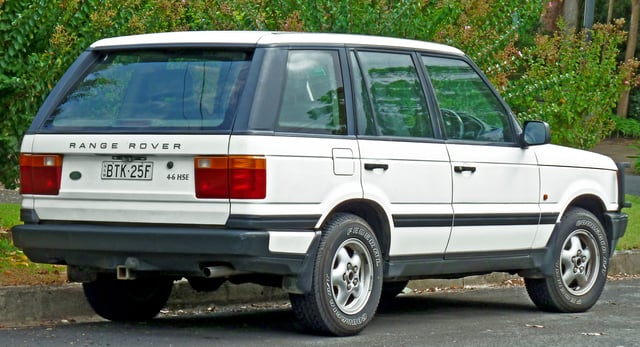
Land Rover Range Rover 4.6 HSE wagon (Australia)
Twenty-five years after the introduction of the original Range Rover, the second-generation (model-designation P38A) was introduced for the 1995 model year, based on the 8 inches (20 centimetres) longer chassis of the old LWB model, and with an updated version of the Rover V8 engine. There was also the option of a 2.5-litre BMW six-cylinder turbo-diesel with a Bosch injection pump. This was the first diesel injection with electronic controls in a Land Rover, before common rails were introduced. This was a result of BMW's subsequent ownership of Rover Group and hence the Land Rover brand.
The new model offered more equipment and premium trims, positioning the vehicle more strongly above the Land Rover Discovery than the old original, to meet the increased competition in the SUV marketplace.
This model was the last to feature the Rover V8 and interior leather supplied by Connolly who went out of business in 2002. It was the first model to feature Satellite Navigation as an option.
Third generation (2002–2012)
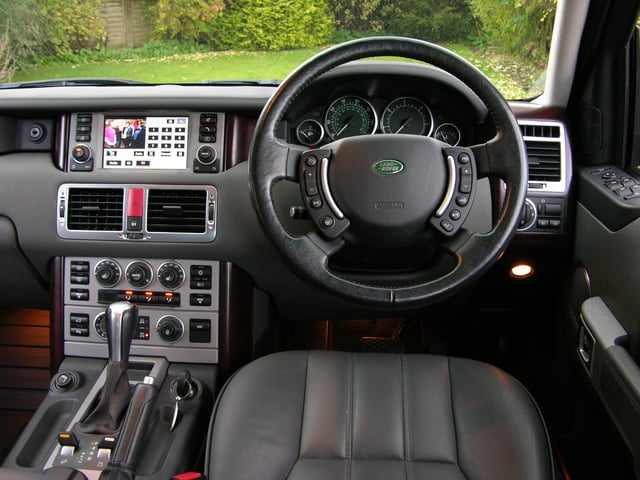
Range Rover interior
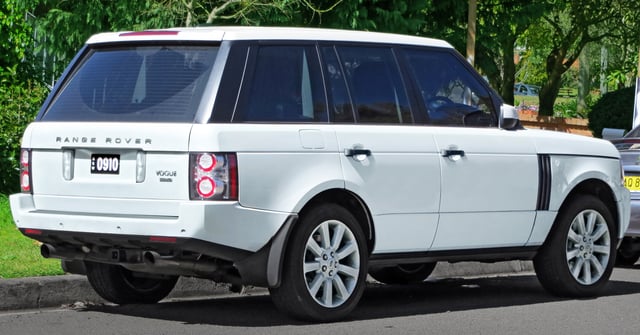
Land Rover Range Rover Vogue (Australia)
In 2002, the third-generation model was introduced, which saw the model move further up-market.
Planned and developed under BMW ownership the third generation was to share components and systems (electronics, core power units etc.) with the BMW 7 Series (E38). It was designed to accommodate BMW's 4.4 litre M62 V8 engines for future models. The manual transmission was dropped entirely, leaving only the automatic. The 7 Series electronics system was being phased out during the development of the third-generation Range Rover and being replaced with the electronics from the BMW 5 Series (E39). Note that there were three "Generations" of the L322, from 2002 until 2005 was the aforementioned M62 BMW V8 with ZF 5HP-24 transmission, going along to 2006 until 2009 a 4.4-litre Jaguar derived engine alongside a 4.2-litre supercharged variant of the Jaguar engine partnered with the ZF 6HP-26 transmission. In 2010 Land Rover fitted the newly designed 5.0 N/A and Supercharged engine with ZF 6HP-26 until the 2012 model year, which saw the end of the L322 production. This list does not give diesel options.
From 2002-2004 the L322 saw a standard BMW E39 electrics system.
From 2005-2009 the L322 saw an updated Jaguar derived electrics system with fibre optics and Bluetooth. From 2010-2012 the L322 saw an updated (different from 05-09) Jaguar derived electrics, the first "modern feeling" system.
In MY06 the first exterior update was applied with a slight face-lift of front fascia, tail lamps.
Some other slight differences can be found on the "Supercharged" variant.
The second exterior update was in 2010, bringing a true modern feel to the L322 with new fascia, tail lamps, side grills, and clear side markers.
The interiors stayed relatively the same with exclusions i.e. Supercharged trim black piano finish until 2006.5, (NAS 2007) where an updated interior was released.
Another major change was in 2010.
Fourth generation (2012–present)
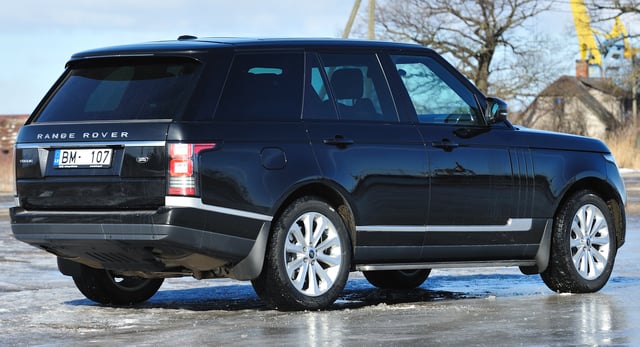
2013 Range Rover Vogue (Latvia)
The fourth generation Range Rover, codenamed L405, was exhibited in September 2012 at the 2012 Paris Motor Show.[14]
Hybrid
The Range Rover Hybrid is diesel-powered hybrid electric model unveiled at the 2013 Frankfurt Motor Show. The ordering process began in September 2013, and retail deliveries in Europe were slated to start in early 2014.[15]
Sales
The success of Jaguar Land Rover since its formation in 2008 is reflected largely in the rising sales of the Range Rover. In 2009, as a severe recession took hold, just over 22,000 were sold. Four years later, it sold more than twice as many units, with more than 45,000 being sold. By 2015, Range Rover sales worldwide exceeded 60,000.
This table excludes Range Rover Sport and Evoque.
The total figure is from 2009, excluding those sold prior to that year.
| Year | Sales |
|---|---|
| 2009 | 22,001 |
| 2010 | 23,602 |
| 2011 | 29,626 |
| 2012 | 27,496 |
| 2013 | 45,077 |
| 2014 | 53,738 |
| 2015 | 60,226 |
| 2016 | 55,728 |
| Total | 317,494 |
Motorsport
Expanded line
Range Rover Sport
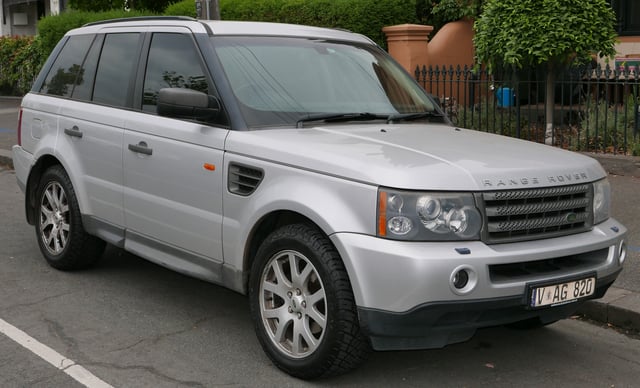
Range Rover Sport (first generation)
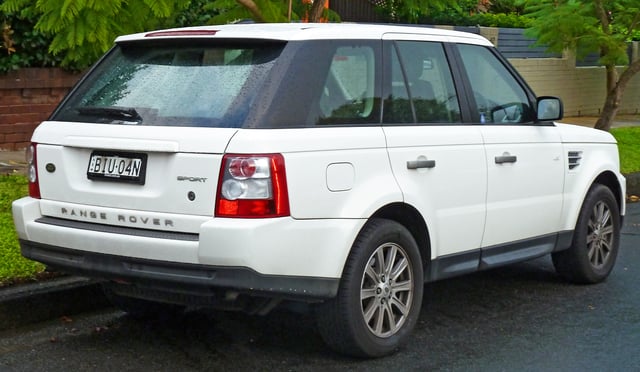
Range Rover Sport (first generation
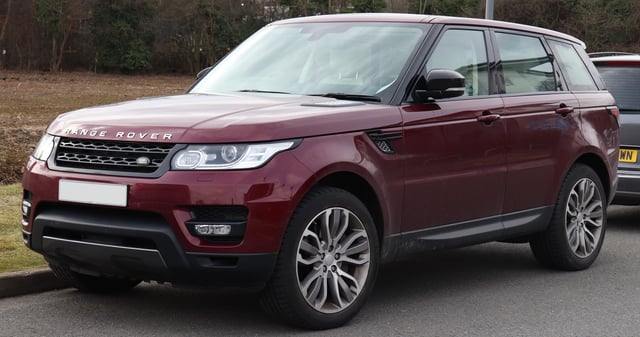
Range Rover Sport (second generation

Range Rover Sport (second generation
On 26 November 2004, Land Rover released the first photographs of the Range Rover Sport, a new model it planned to show to the public for the first time at the 2004 North American International Auto Show. The Range Rover Sport is a production car development of the Range Stormer concept vehicle the company showcased in the 2004 North American International Auto Show. Though called the Range Rover Sport "L320", it was not merely a new specification within the Range Rover line-up, but rather an adapted Discovery "L319", or T5 Platform Discovery/LR3 with Range Rover exterior styling and Range Rover interior seating and dash forms, a shortened wheelbase, smaller luggage capacity and a single rather than split tailgate which was angled back for styling improvements. With entry model pricing close to upper Discovery models, the Sport became the biggest seller of all the Land Rover products. This model was released for sale in late 2004 as a 2004 model.
In 2013 a redesigned version was released for sale as a 2014 model year "L494".
Unlike the original and current Discovery, it does not have a steel chassis rails but is based on the new D7u alloy Platform, which much more resembles current flagship Range Rover with closer equipment levels and capabilities in a smaller body style.
Hence the L494 Range Rover Sport is around 400 kg lighter than the previous generation and benefits in performance due to its weight reduction.
Range Rover Evoque
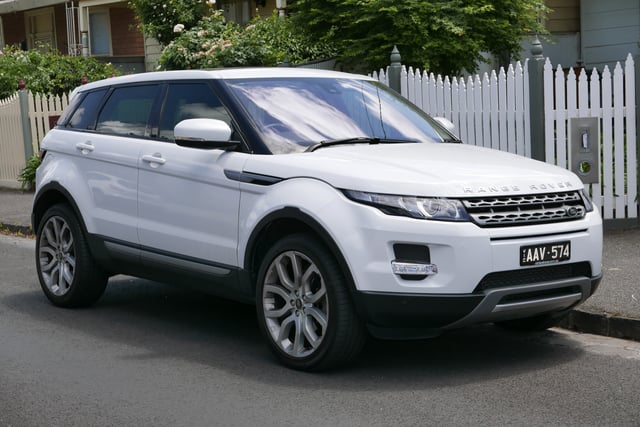
Range Rover Evoque five-door
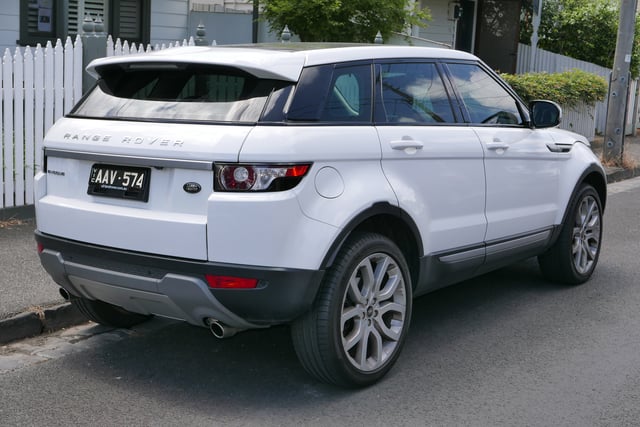
Range Rover Evoque five-door
The Range Rover Evoque, which went into production in July 2011, has its roots in the Land Rover LRX concept car; with which it bears an almost identical resemblance. It is available with either a three-door or five-door hatchback body, front-wheel drive or four-wheel drive and with a 2-litre turbocharged petrol engine or one of two different power output 2.0-litre turbo-diesel engines.
In 2012, at the Geneva Motor Show, Land Rover unveiled a convertible concept, which featured four seats and a drop-down tailgate.[19]
Range Rover Velar
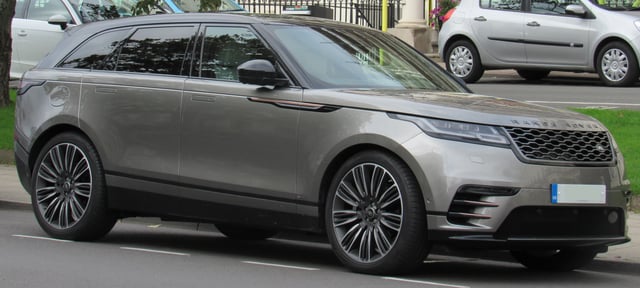
Range Rover Velar
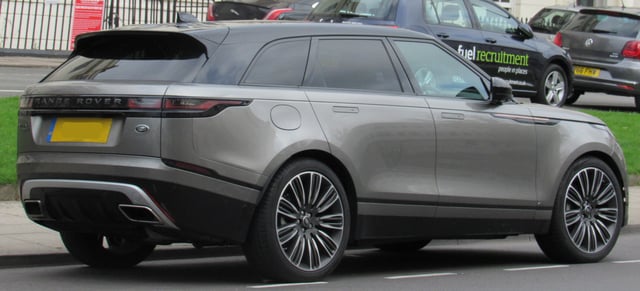
Range Rover Velar
Land Rover unveiled a mid-size crossover using the Range Rover name in March 2017. Named the Range Rover Velar, it has a roof line running away on its bodywork and uses the same platform as the Jaguar F-Pace, which serves as the basis for its design.
Advertising
A song titled "I Found a Place in My Heart" and "Find Your Heaven", co-written by Dom James and Tommy Antonio for Range Rover commercials, is sung by Emma Smith.[20]
Criticism
In 2004, Spen King criticised SUV owners who drove their vehicles in urban areas, saying that vehicles like the Range Rover he created were "never intended as a status symbol but later incarnations of my design seem to be intended for that purpose."[23]
In 2014 it was reported that Range Rovers could be opened and started using hand-held equipment readily available from eBay.
High levels of theft rendered Range Rovers not insurable.[24]
Range Rovers, according to AutoTrader, "can be complicated, costly vehicles, and are loaded with very expensive parts."[25] Reliability issues are common complaints.[26] J.D. Power rankings for the Land Rover are in the lowest category - known as "The Rest" - for quality overall, dependability, sales satisfaction, and customer service, with the cars only earning a "Better than Most" rank in the performance and design overall category.[27] The Land Rover brand has "a legacy of quality problems" and ranks "at the bottom of the J.D. Power reliability ratings for three-year-old vehicles".[28] The JD Power 2014 U.S. Customer Service Index (CSI) study ranked Land Rover last in overall customer satisfaction.[29] However, one Motor Trend review of a 2014 Range Rover after 22,830 miles (36,741 km) turned up only two things that went wrong with the car.[30] According to an automotive journalist, "Land Rover doesn't care about JD Power ratings because it doesn't need to care" since people "still line up for months to pay full sticker."[31][32]